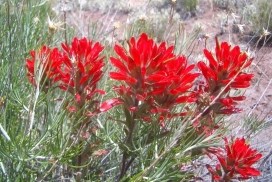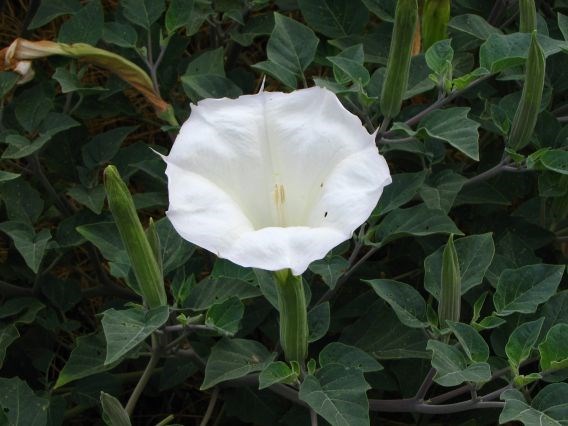|
The high temperatures, limited rain, and drying winds of the desert can present a harsh environment for wildflowers. These unforgiving conditions make the abundance of Zion’s wildflowers seem even more spectacular, set against a backdrop of towering sandstone cliffs. 
NPS/Pete Sawtell In the early spring, many plants take advantage of the seasonal rains, to flower and reproduce quickly, before the precious water is gone. Flowers like the desert marigold (Baileya multiradiata), or the eye-catching slickrock paintbrush (Castilleja scabrida), often take visitors by surprise with their brilliant colors in early-to-mid April. 
NPS/Pete Sawtell Zion’s many springs and seeps also provide micro-habitats where temperatures are cooler and water is available year round. Throughout the summer, on the Weeping Rock, Emerald Pools, and Riverside Walk trails, you may see “hanging gardens” where flowers like shooting star (Dodecatheon pulchellum), golden columbine (Aquilegia chrysantha), and scarlet lobelia (Lobelia cardinalis) cling tenaciously to the cliff walls. 
NPS/Robin Hampton Large, delicate flowers like the sacred datura (Datura wrightii) and Bridge’s evening primrose (Oenothera longissima), which wilt in the heat of the day, bloom at night in cooler temperatures. Others, like the datil yucca (Yucca baccata), have flower petals with a waxy coating. A waxy coating, or cuticle, allows the petal to retain water and withstand the drying heat. Still other desert survivors, like elkweed (Swertia radiata), bloom in the high elevation of Zion’s plateaus where the temperatures are cooler and rains are more frequent. Wherever you find them, the wildflowers of Zion National Park give you the feeling you’ve stumbled upon a secret treasure, an extra splash of color in the dry, red rock desert. 
Plants
Zion National Park has a diversity of plant communities 
Zion Herbarium
Zion has a collection of over 3,000 plant specimens. 
Inventory and Monitoring
Scientists in Zion collect, interpret, and manage data to help manage and protect the park's resources. |
Last updated: July 8, 2024
